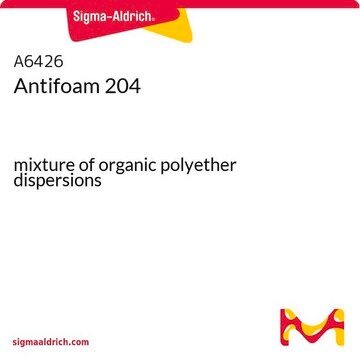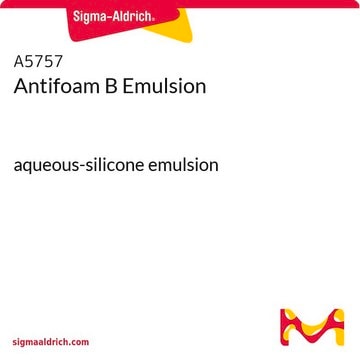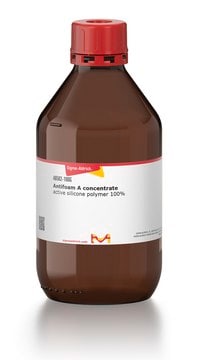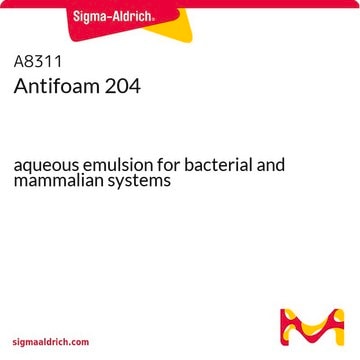If this product has an expiration or retest date, it will be shown on the Certificate of Analysis (COA, CofA). If there is no retest or expiration date listed on the product's COA, we do not have suitable stability data to determine a shelf life. For these products, the only date on the COA will be the release date; a retest, expiration, or use-by-date will not be displayed.
For all products, we recommend handling per defined conditions as printed in our product literature and website product descriptions. We recommend that products should be routinely inspected by customers to ensure they perform as expected.
For products without retest or expiration dates, our standard warranty of 1 year from the date of shipment is applicable.
For more information, please refer to the Product Dating Information document: https://www.sigmaaldrich.com/deepweb/assets/sigmaaldrich/marketing/global/documents/449/386/product-dating-information-mk.pdf
A8011
Antifoam C Emulsion
aqueous-silicone emulsion
Synonyme(s) :
Antifoaming Agent Emulsion
Sélectionner une taille de conditionnement
Sélectionner une taille de conditionnement
About This Item
Produits recommandés
Source biologique
synthetic
Niveau de qualité
Forme
emulsion
Contient
emulsifier
Technique(s)
cell culture | hybridoma: suitable
microbiological culture: suitable
Pf
0 °C (32 °F)
Catégories apparentées
Description générale
Application
- as a supplement in RO-H2O and a chemically defined culture medium to determine volumetric mass transfer coefficient (kLa) of mammalian cell culture[2]
- as a component of feed medium[2],
- as a steam-sterilized antifoaming agent in a biocontroller for pH-stat fed-batch cultivations[3]
- as a supplement in fed batch medium to mimic the typical large-scale cultivation conditions[4]
Caractéristiques et avantages
- Minimizes compatibility issues with biological systems
- Highly effective defoamer at low concentrations
- Highly effective and versatile silicone defoamer
Autres remarques
Mention d'avertissement
Warning
Mentions de danger
Conseils de prudence
Classification des risques
Eye Irrit. 2 - STOT SE 3
Organes cibles
Respiratory system
Code de la classe de stockage
10 - Combustible liquids
Classe de danger pour l'eau (WGK)
WGK 3
Point d'éclair (°F)
Not applicable
Point d'éclair (°C)
Not applicable
Équipement de protection individuelle
Eyeshields, Gloves, type ABEK (EN14387) respirator filter
Faites votre choix parmi les versions les plus récentes :
Certificats d'analyse (COA)
Vous ne trouvez pas la bonne version ?
Si vous avez besoin d'une version particulière, vous pouvez rechercher un certificat spécifique par le numéro de lot.
Déjà en possession de ce produit ?
Retrouvez la documentation relative aux produits que vous avez récemment achetés dans la Bibliothèque de documents.
Les clients ont également consulté
-
How can I determine the shelf life / expiration / retest date of this product?
1 answer-
Helpful?
-
-
How is shipping temperature determined? And how is it related to the product storage temperature?
1 answer-
Products may be shipped at a different temperature than the recommended long-term storage temperature. If the product quality is sensitive to short-term exposure to conditions other than the recommended long-term storage, it will be shipped on wet or dry-ice. If the product quality is NOT affected by short-term exposure to conditions other than the recommended long-term storage, it will be shipped at ambient temperature. As shipping routes are configured for minimum transit times, shipping at ambient temperature helps control shipping costs for our customers. For more information, please refer to the Storage and Transport Conditions document: https://www.sigmaaldrich.com/deepweb/assets/sigmaaldrich/marketing/global/documents/316/622/storage-transport-conditions-mk.pdf
Helpful?
-
-
Will there be a problem if I add 100ppm of antifoam when cultivating bacteria?
1 answer-
This product is typically effective at 1-10 ppm. Therefore, there is no guarantee how 100 ppm will perform for bacteria cultivation.
Helpful?
-
-
Can the antifoam be autoclaved pure? When diluted (e.g. to 0.5% or 0.1%)?
1 answer-
Yes, this product may be autoclaved. Autoclaving the pure product may result in phase separation and might require remixing the emulsion.
Helpful?
-
Active Filters
Notre équipe de scientifiques dispose d'une expérience dans tous les secteurs de la recherche, notamment en sciences de la vie, science des matériaux, synthèse chimique, chromatographie, analyse et dans de nombreux autres domaines..
Contacter notre Service technique













